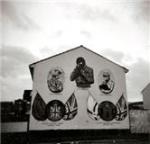I love guest blogging with other artists as it allows all of us to see and read about things we might not normally find on our own. Here’s the latest guest blog by photographer Joe Western, a talented guy I met on Facebook (& check out the link to his blog on the right side bar…I’m a guest on his blog as well!):
A Northern Industrial Town
Back in January of this year, I had set out on my first trip to London with some friends. Deciding first to fly into Dublin, then taking a bus up to Belfast for a few days. Unfortunately we never made it to Dublin, and due to a major snow storm, were diverted directly to Belfast. Though I was looking forward to checking out things like The Book of Kels, and the Oscar Wilde House, Northern Ireland’s capitol city had it’s own historical allure – especially music wise – to keep me intrigued…
These photos were taken with the Holga, a cheap plastic ‘toy’ camera with minimal features, utilized by many photographers for the novelty of its often dreamy, and ethereal qualities – or flaws, depending on how you look at it.
The Cathedral Quarter located in the easterly side of the City Centre, is a sort of up-and-coming area. There are galleries such as the Red Barn, and Oh Yeah Music Centre (everyone I met seemed to pronounce it as Oh Yay) which had a fantastic retrospective on the local music scene, displaying everything from a bottle of Thin Lizzy whiskey to one of the Undertone’s leather jackets. Around the corner is The Black Box cafe, which is also a few doors down from what was once the Harp Bar, a local venue which hosted many a punk gig throughout the 70s and 80s. Saint Anne’s Cathedral stands at the corner of Donegal and Academy Street, with a towering Celtic cross adorning its facade. Several blocks down are the burnt out remnants of what once was the North Street Arcade, notable as being the former location of Terri Hooley’s Good Vibrations record shop and label – the man who of course introduced the world to a Derry band called the Undertones, as well as other exciting NI bands like Rudi, and The Outcasts.
The Shankill located in the Western part of the city is a dominantly Protestant neighborhood. It directly borders the dominantly Catholic Falls Road area – location of the Sinn Fein headquarters. The two communities are divided by one of the first peace lines to be built at the beginning of The Troubles in the late sixties. On both sides of the wall, large murals in tribute of fallen members of various paramilitary groups adorn the sides of many housing estates. The wall which extends west from the city center and separates the Shankill and Falls Road is not the only peace line that divides the Protestant-Loyalist, and Catholic-Republican communities, there are around 40 separate walls dividing the two communities into many different pockets throughout the city. There are ‘Black Taxi Tours’ which can be arranged, and will take you through these West Belfast neighborhoods to see the various political murals, and whose drivers will explain a bit of the history. A seemingly odd, and slightly morbid attraction in some respects, but I imagine they must be fairly popular, and they will indeed give you a better understanding of the country’s long standing conflict.
A walk down Great Victoria street will lead you past several notable Belfast landmarks. First is the Europa hotel, with a reputation as being Europe’s ‘most bombed hotel’ as well as accommodating The Clash on their famously canceled Belfast debut. Further on down, past the notable Crown Bar, and Queen’s University, you would come to the Belfast Botanical Gardens. Coming down Great Victoria one night, I paused to take in the amazing sight of countless flickering street lights shining in the hills surrounding the city, which could be seen over the rooftops of West Belfast. Though I didn’t capture it on film, it’s the image I recall most vividly when I think of my time in the city.
Johnny Thunders upon visiting Belfast in the late eighties described it as something “like Detroit used to be in 74”, which was at a time when the City Centre was still barricaded and guarded by check points. Since the Good Friday agreement in 1998, which required the IRA to decommission it’s weapons in exchange for the release of political prisoners, violence in the city has been on the downturn. There is still reports of rioting as recently as this year, when Protestants march through Catholic neighborhoods to celebrate King William’s 1690 victory over the Irish, proving that many still hold to their sectarian attitudes. Though Belfast rarely makes it to the top of anyone’s list of travel destinations, let alone in the middle of January, it’s quite a different experience in comparison to the countless stories I’ve heard of people’s visits to Dublin – which more or less amount to a trip to the Guinness Factory, or possibly the Jameson Distillery if daring enough. Most importantly, I gained a much better understanding of Northern Ireland’s historical struggle for independence, and a stronger sympathy for the hardship it’s people have endured over the centuries. We then moved on to spend a few days in London, something I had looked forward to for years, but with the kindness and hospitality shown by those I met in Belfast it left an overall impression that was hard to match.


